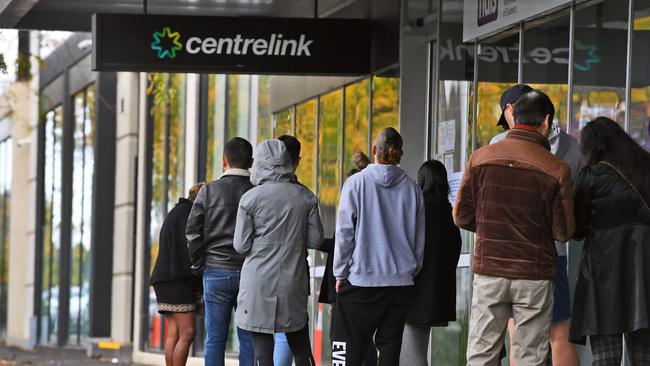Older Australians relying on JobSeeker payment, Parliamentary Budget Office says
The age of Australians accessing JobSeeker is trending up, placing pressure on the federal budget as older Victorians use the unemployment benefit as a pre-pension.

News
Don't miss out on the headlines from News. Followed categories will be added to My News.
The JobSeeker dole payment is turning into a pre-pension, with unemployed older Australians relying on it for longer and one in five recipients having received it for more than five years.
The Parliamentary Budget Office warns the unemployment benefit — worth up to $565 a fortnight plus a $250 coronavirus supplement — is placing increasing pressure on the federal budget because recipients are increasingly older and unable to work.
The trend was clear before COVID-19, which saw the number of people on JobSeeker skyrocket from 793,000 in March to 1.45 million by last month, including 378,474 Victorians.
By 2019, two-thirds of dole recipients had been receiving taxpayer-funded help for more than a year, compared to 50 per cent in 2007.
The PBO’s analysis, released on Wednesday, also showed two out of five Australians on the dole were men aged under 35 in the 1990s. By last year, this proportion fell to one in six, with half of JobSeeker recipients aged over 45 and 15 per cent aged over 60.
The PBO found older people and women were increasingly relying on the dole for longer because of changes to the eligibility criteria for parenting, disability support and pension payments.
Of JobSeeker recipients aged over 55 last year, 33 per cent of women and 29 per cent of men had relied on the benefit for more than five years.
In turn, half of women and nearly 40 per cent of men on JobSeeker were not having to search for jobs before the pandemic hit, mostly because those aged over 55 were exempt if they completed some paid or voluntary work.
“JobSeeker appears to be functioning as a kind of pre-age pension payment for some older Australians,” the PBO said.
With the qualifying age for the pension increasing to 67, it said this trend was likely to continue as it was typically more difficult for older Australians to find work.
Prior to this year’s recession, the nation’s $170bn social security bill made up 35 per cent of total commonwealth spending, although JobSeeker payments cost $9.7bn compared to $66bn for pensioners.
The PBO found that while more men than women were accessing JobSeeker because of the pandemic, more women were losing their jobs or leaving the labour force altogether.
“If it were to persist, this pattern would represent a material risk to the budget over the medium term,” it warned.
“This is because strong female participation rates have made an important contribution to economic growth in recent decades.”
At the end of September, the coronavirus supplement for those on JobSeeker was slashed by $300 a fortnight to $250.
It will remain at that level to the end of the year, with the government indicating extra support may continue into 2021, instead of cutting the benefit back to $40 a day.
MORE NEWS
MORRISON PLEDGES $100M RECHARGE FOR HARD-HIT REGIONS
PM SLAMS SHIPPING DISPUTE AMID SUPPLY CHAIN CHAOS

